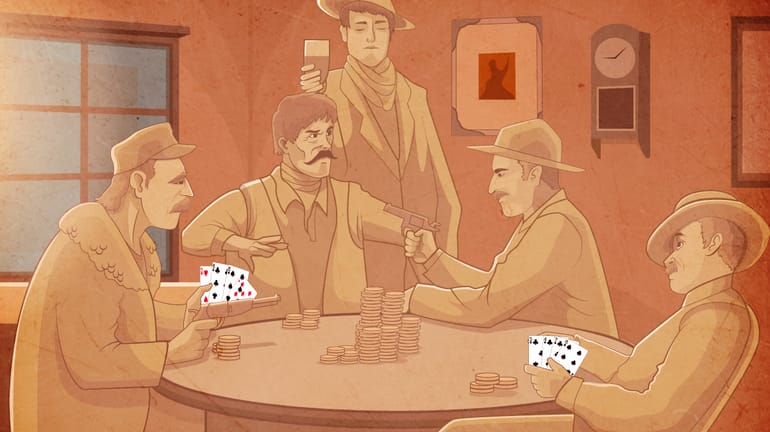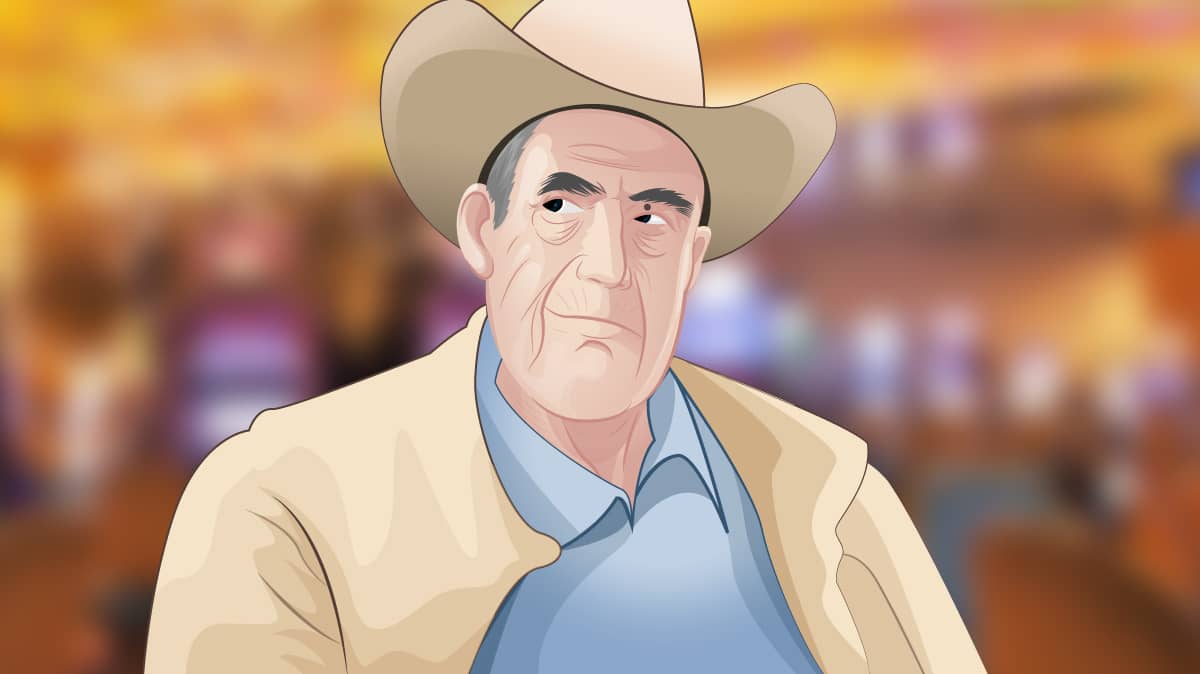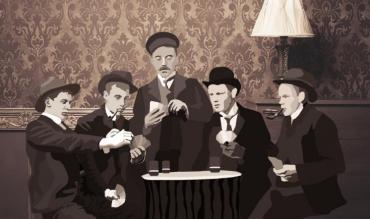To jump in on a poker game is to be part of a game that traces its history back generations. From Civil War soldiers and Old West saloons to old Vegas and the early days of the online game, poker has a deep history and culture.
That past includes a tapestry of colourful characters, locations, and a constantly evolving game. Here’s a look at some of that history.
Early Poker Origins
The origin of poker is shrouded in a bit of mystery. Many believe the game may have derived from several games. Others think the modern game probably came from a French called poque.
- That original game used a 20-card deck utilising only the Ace, King, Queen, Jack, and Ten.
- Poque was introduced to the French colony of Louisiana in the late 18th Century.
- It took on an Americanised name as the game evolved in the early 1800s.
Many poker rules carried over from poque. But the deck expanded to 52 cards between 1830 and 1850. Straights and flushes also came into play.
It’s also during the 19th Century that the game took on an unscrupulous reputation. Cardsharps frequented riverboats moving Americans up and down the Mississippi.
These players took advantage of unsuspecting passengers in games against much more skilled players. Games also frequently involved collusion, sleight of hand, and other cheating methods to separate a passenger from his money.
As a young man, author Mark Twain worked on these riverboats and even became a poker player himself. He offered a warning to those who knew little about the game who were tempted to play.
|
“There are few things that are so unpardonably neglected in our country as poker,” the author noted. “The upper class knows very little about it. Now and then, you find ambassadors who have sort of a general knowledge of the game, but the ignorance of the people is fearful. “Why, I have known clergymen, good men, kind-hearted, liberal, sincere, and all that, who did not know the meaning of a "flush." It is enough to make one ashamed of one's species.” |
Old West and Civil War Era
 Old West and Civil War Era
Old West and Civil War Era
The modern game of Texas Holdem was still quite a way off. But by the mid-19th Century, many in the U.S had embraced poker. Draw and stud poker games were popular at the time.
During the Civil War (1861-65), quite a few Union and Confederate soldiers were known to gamble while encamped between battles. According to History.net, Virginia Union soldier Alexander Hunter believed five of six soldiers played cards.
| “Some soldiers gambled day and night; draw poker, of course, being the game,” He wrote: “When out of money, a man stayed in the game by resorting to the use of ‘O.P.s’ [these were IOUs on the Order of the Paymaster].” |
During westward expansion, saloons and gambling joints popped up all along the frontier. Cowboys, entrepreneurs, and miners headed west during the gold rush all mixed it up at the card tables.
Lawmen and outlaws alike enjoyed time at the tables, including the following gunslingers:
?Doc Holliday
?Pat Garrett
?Bat Masterson
?Luke Short and many others
But these were far from the modern casinos offering fair games.
These gambling dens were usually smoky and poorly lit. Playing cards weren’t easily found and were used over and over again. Bent cardswere common, many of which had been marked intentionally by dishonest players.
In 1876, lawman, gambler, and gunslinger Wild Bill Hickok had moved to Deadwood, located in the Black Hills of the Dakota territory. He planned on settling in the mining town to play poker and earn his living.
On Aug. 2 of that year, Hickok was in a Five Card Stud game at Nuttal and Mann’s Saloon. While playing, he was shot in the back and killed while holding two Aces and two Eights. The tale remains one of the best known in poker.
Aces and Eights has since been known as Dead Man’s Hand.
The Birth of Texas Hold’em
It’s believed Texas Hold’em first debuted in the early 1900s as an altered version of Seven Card Stud. The use of community cards was something new to poker. But it has gone on to become the most popular form of poker in the world.
Robstown, Texas, is recognised as the game’s birthplace. Texas poker legends like Doyle Brunson were playing the game quite a bit by the 1950s. The game was brought to Las Vegas by the 1960s.
 Texas Poker Legend Doyle Brunson
Texas Poker Legend Doyle Brunson
- Poker’s popularity grew throughout the 20th Century. As soldiers returned home after World War II, poker nights became a regular part of life for many Americans. Even the television sitcom The Odd Couple regularly featured a card game.
- Several presidents even got in the action. Richard Nixon is said to have been exceptionally skilful at the card table. He financed some of his first political campaign with poker winnings.
- Poker received plenty of pop culture references, including a major film treatment with the release of The Cincinnati Kid in 1965. It starred Hollywood heavyweight Steve McQueen.
Poker remained a passion for many in the military as well. Even the WPT Mike Sexton learned the game while deserving as an Army paratrooper in the early 1970s.
World Series of Poker
The creation of the World Series of Poker(WSOP) moved the game of poker beyond back rooms into the spotlight. It wasthe brainchild of Benny Binion. He was a Texas gangster who eventually traded his illegal gambling operations in Dallas for legal casino ownership in Las Vegas.
Binion took ownership of the Horseshoe in 1951. The property became famous for taking some of the largest bets in Vegas.
Ever a showman, Binion always looked to bring more gamblers in the doors. In the late ‘60s, the idea struck him that a high-stakes poker game might attract some onlookers.
He hoped to bring in some of the best players in the country, many of whom he knew from his life in Texas.
The first event was held in 1970 and attracted a handful of players, including the following poker legends:
- Doyle Brunson
- Johnny Moss
- Amarillo Slim Preston
That first year, there was only cash game action, and the players voted on the best player.That was Moss, and he’s considered the winner of the first WSOP.
Binion added a Texas Hold’em tournament format a year later, and Moss won again.
In 1972, the buy-in was for $10,000, and Preston took the title. His colourful personality and television appearances gave the series some excellent publicity.
The series continued to grow, adding side events, attracting more players. The championship gold bracelet was added as a trophy in 1976, which has become the biggest prize in poker.
- Bigger fields continued and then exploded in the 2000s with Chris Moneymaker’s unlikely win in the Main Event in 2003. For the first time, viewers at home could see hole cards captured by ESPN cameras.
The World Poker Tour’s popularity also grew alongside the numbers of online players. These occurrences helped launch the poker boom that saw poker explode.
There are many events each summer at the WSOP with hundreds of thousands of competitors. The 2019 Main Event paid out $10 million to the winner, Germany’s Hossein Ensan.
 2019 WSOP Main Event $10 Million Winner Hossein Ensan
2019 WSOP Main Event $10 Million Winner Hossein Ensan
Televised Poker, the World Poker Tour
Many believe the WSOP was the first televised poker show allowing viewers to see hole cards. But that title goes to the British program Late Night Poker, which ran from 1999 to 2002 and then returned in 2008 to 2011.
Poker had never been televised in the United Kingdom before the show premiered. The show featured the following players:
- Dave “The Devilfish” Ulliot
- Surinder Sunar
- Victoria Coren
- Al Alvarez
The show was popular with viewers and also produced several spinoffs.
Then in 2003, an even bigger show hit television. This version offered a look at some of the biggest tournaments in the world, from prestigious casinos in exotic locations.
- The World Poker Tour(WPT) debuted in 2002 on the Travel Channel in the US. Players battled it out for huge prize pools not seen by most television viewers.
The high-quality production featured Mike Sexton and Vince Van Patten calling the action on the felt. Viewers were intoxicated by the ungodly sums of money, elegant casinos, and personalities at the tables.
- No-Limit Texas Hold’em was also new to most viewers, and the game surged in popularity.
Allowing players to see hole cards also became a game-changer for televised poker. More shows came and went throughout the 2000s and 2010s, but the WPT and WSOP remained mainstays.
The WPT now runs tournaments throughout the world and is seen in 150 countries. In 2017, the tour officially reached the billion-dollar mark in prize money paid out.
Online Poker Boom
The success of the modern game owes plenty of thanks to online poker. The industry was born in the early 1990s. Players began with more rudimentary versions for play money in the early days of the Internet.
Planet Poker became the first operator allowing people to play for real money when it debuted on Jan. 1, 1998. But technical issues plagued the site - that even lasted for days at times.
Adding new features was also not an easy process. The Internet was also new and brought challenges not seen by players in the modern game. Most players were on dial-up connections.
- In 1999 another operator entered the industry – Paradise Poker. This site offered players better features and an improved gaming experience.
Both sites continued to grow but began facing competition in the early 2000s.
- These new competitors offered a superior software experience and were better funded. That included 888poker, which was launched in 2002.
These new rivals spent large marketing budgets. This strategy involved sponsoring major live tournaments to attract players and grow the industry.
- The 2000s saw online poker boom along with televised poker, the WSOP, and WPT.
According to Grand View Research, the industry’s market size reached $53.7 billion by 2019. The firm expected growth at a compound annual growth rate of 11.5 percent from 2020 to 2027.
Twitch, Streaming, and Podcasting
 Poker Twitch, Streaming, and Podcasting
Poker Twitch, Streaming, and Podcasting
The poker boom slowed by the late 2000s. The U.S. federal government cracked down on online poker. But by 2013, the game was back in regulated environments. Nevada, New Jersey, and Delaware now allow online play.
On a broader scale, new sites like YouTube and Twitch in the mid-2010s offered a new opportunity for creative poker players. Players like Jason Somerville began to use these sites to deliver unique content and build significant audiences.
- Twitch offered players a way to connect with other players as they played online. Many presented fun streams that could include strategy advice and other entertainment.
- Twitch had been primarily used to stream video games, but poker found a comfy home as well. A by-product was that streamed poker channels began reaching new players. People who went to Twitch for esports were also checking out poker.
YouTube has offered another opportunity to add exciting poker content. That’s included the following content creators:
- Online operators
- Poker tours
- Players showing hands played
- Poker strategy advice
- Poker lifestyle videos
Poker vlogs have gained traction in recent years, with players like Daniel Negreanu documenting their poker life. PokerGO is another excellent poker media option.
The channel allows players to watch WSOP action as well as high roller tournaments. They also offer documentaries and new episodes of Poker After Dark and High Stakes Poker.
Podcasting has added to the poker media offerings throughout the 2010s and continues to gain listeners.
By 2021, there was a podcast for every type a player might imagine – from hardcore poker talk and strategy to interviews and lifestyle.
★★★
The history of poker can be traced back hundreds of years. The game has transitioned from a game played in back rooms with cheating always a possibility.
Nowadays, it’s a game played out in front of cameras in casinos around the world.
It has evolved to include its own culture, stories, literature, and characters. Those heading to the tables for a game of poker are part of that rich history, keeping the spirit of the game alive.
Frequently Asked Questions
Where did the game of poker come from, and how did it get the name?
- Many believe poker derived from a French game called poque. The game was introduced to the French colony of Louisiana in the late 18th Century.
- The game soon became Americanised in the early 1800s, including the name. Poque used a 20-card deck utilising only the Ace, King, Queen, Jack, and Ten. Early poker versions also used this deck.
When was Texas Hold’em invented?
- The game is believed to have been first played in Texas in the early 1900s, with Robstown as its birthplace.
When was the first World Series of Poker?
- Horseshoe Casino owner Benny Binion the series in 1970 to bring more gamblers into the property.
When did online poker debut?
- Free money poker traces its origin to the 1990s during the early days of the Internet. Planet Poker became the first company offering real money online poker in 1998. 888poker debuted in 2002.
What was the first televised poker show allowing viewers to see hole cards?
- Late Night Poker debuted in the UK in 1998 and allowed viewers to see players’ cards.
- The World Poker Tour became the first show for US audiences to show hole cards. The tour greatly expanded the use of “hole card cams” and found instant success.
- In 2003, ESPN showed hole cards for the first time at the World Series of Poker, which Chris Moneymaker won. The WPT and 2003 WSOP, along with the growth of online poker, helped kickstart the poker boom of the 2000s.


